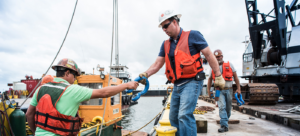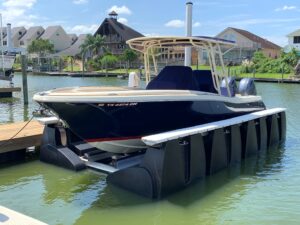A marine contractor specializes in building maritime structures, like jetties, boat lifts, and bulkheads. Look for a company with stable, experienced leadership who can continuously deliver quality services. For more information, you can click the Visit Website to proceed.
Marine contractors face major perils that can halt operations and sink profits. They require tailored insurance that protects against these risks.

When choosing a marine contractor for your coastal project, look at their professional experience. A well-established marine contractor will have years of experience building various structures in and around the water. They will know what to look for in different materials and how to navigate the challenges of working in a marine environment. They also have the expertise to provide a complete design-build solution for any marine construction or repair project.
In addition to their professional experience, you should also discover their industry reputation. Ask for references from previous clients and contact them to learn more about their customer service experience. In addition, make sure to ask for a copy of their insurance policy before hiring a marine contractor. This will help you avoid any surprises down the road.
The marine industry is complex and specialized, so you want to ensure your marine contractor has the right experience. In addition to their extensive knowledge of the ocean and its shoreline, they should be able to provide you with detailed information about the types of projects they have completed in the past. This will allow you to decide whether they are the right fit for your project.
Looking for a company with a stable business model and long-tenured leadership is also important. This will indicate that they are committed to meeting their customer’s needs and providing a high level of service. They should also have solid relationships with their vendors, which indicates that they are financially sound and able to meet their commitments.
Marine contractors play a crucial role in the smooth operation of maritime businesses and contribute to efficiency and sustainability. However, their work is risky and requires specialized insurance coverage. Tailored insurance will protect their equipment, employees, and profits. In addition, this type of coverage will help them adapt quickly to changing regulations at the state and international levels.
A marine contractor must have the proper licenses to operate their business. This includes a marine construction license and workers’ compensation insurance. It is important to check with your State’s governing body to see what the requirements are for your area. You should also ensure the marine contractor has a strong reputation and a stable ownership structure. This will help them invest in safety and quality projects and stay financially sound during slow business times.
Unlike building on the land, building in water is much more complicated. The process requires specialized equipment and experience working in tidal waters. This makes finding a marine contractor with the right skills and expertise essential. You should ask a marine contractor for references from previous clients and speak with them directly to see their experiences. You can also check online for reviews and testimonials from past customers.
Marine contractors must adapt to rapidly evolving regulations at all levels, including State, federal, and international. They must also rely on new technologies to stay competitive and become more sustainable. For example, Sinay provides marine contractors with high-quality metocean data and state-of-the-art tools to make better decisions, improve operational efficiency, and reduce downtime caused by weather conditions.
To be licensed as a marine contractor, a person must have two years of full-time maritime construction experience and pass the marine contractor exam administered by the MCLB. A marine contractor must also have commercial general liability and workers’ compensation insurance. To renew their license, a marine contractor must complete 12 hours of MCLB-approved continuing education.
In addition, marine contractors must have a permit from the governing body to work in tidal wetlands. This includes dredging and filling; the construction, demolition, repair, alteration, or excavation of docks, seawalls, bulkheads, or other structures; and other activities that may be located in or over State or private tidal wetlands.
Choosing the wrong marine contractor can cost you time, money, and possibly your safety. Research and select a professional, licensed, and insured company. The best marine contractors are committed to providing the highest-quality service. They will be visible on-site, reachable, and responsive to their clients. They will also offer clear estimates, upfront pricing, and a project schedule.
Marine contractors have a unique risk exposure and need insurance designed specifically for their business. Marine general liability policies, similar to Commercial General Liability, include coverage for bodily injury, property damage, and personal/advertising injury during a marine contractor’s work. They may also have hull, protection, and indemnity (P&I) coverage, which protects against damage to a vessel and legal liability for collisions between ships or with fixed installations. They can also include completed operations and product/marine pollution insurance, which covers the cost of cleanup or litigation related to accidental pollution hazards discovered after a project.
Other important coverages for marine contractors include a builder’s risk policy, which protects the construction work in progress from fires, lightning strikes, and other natural disasters. Equipment coverage, formally known as inland marine, protects a marine contractor’s tools and machinery, whether in storage or field use. It can be purchased as a separate policy or as an add-on to a general liability insurance program.
Workers’ compensation is also a critical coverage for marine contractors. The United States Longshore and Harbor Workers’ Compensation Act (USL&H) requires that certain employees be covered under a separate workers’ comp policy. USL&H coverage is typically available for employees of marina operators, ship repairers, charterers, stevedores, and terminal operators.
The marine industry is highly competitive, so marine contractors must have a comprehensive insurance program to ensure they are fully protected in the event of an accident or loss. By providing the right insurance, marine contractors can focus on the quality of their work and avoid costly claims. By working with an experienced independent insurance broker who understands the risks associated with marine contracting, marine contractors can be sure they have all the coverage they need to continue to do their best work. Contact Merrimac to discuss your unique needs and learn about all the different insurance options available for marine contractors.
Marine contractors face unique challenges in their work, including using specialized equipment and compliance with strict environmental regulations. These factors make marine construction projects expensive and challenging to complete, so choosing a contractor with the right technology is crucial for success.
Advanced construction technologies like 3D modeling software and survey management systems can improve design efficiencies and minimize the risk of costly mistakes during project development. These tools can also help marine contractors plan for and execute large-scale marine projects such as dredging, constructing piers/docks, piling for wharves/piers, rock dumping or excavation, or underwater construction using remotely operated vehicles (ROV).
The most common materials used in marine construction are steel, concrete, and timber. Steel is preferred because it offers a combination of strength and durability and is lightweight enough to be easily transported over water. Concrete is another popular material for marine construction projects, as it provides exceptional strength and resistance to corrosion. Lastly, timber is also commonly used in marine construction projects but requires regular maintenance to preserve its structural integrity.
Positioning and surveying equipment and materials are critical during dredging and other marine construction projects. Marine contractors must utilize real-time sensor data gathering and visualization capabilities to ensure accuracy and safety. These systems can display information alphanumerically or graphically and can be presented as models, tables, files, volumes, nautical charts, or reports. This can help ensure that all crew members have access to the most up-to-date information and allow them to stay focused on the task at hand.
Metocean data is also important for marine construction companies because it can provide insight into the weather conditions that may affect their operations. This data can help them decide the best time to conduct their activities and minimize downtime due to bad weather.
HCSS HeavyBid makes it easy for marine contractors to compile cost data and stay on budget. This software helps marine contractors save time by automating the dredging estimation process. It can also help prevent overspending by providing a clear communication path between all parties.
